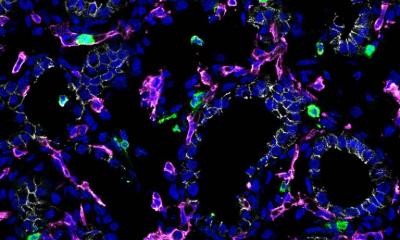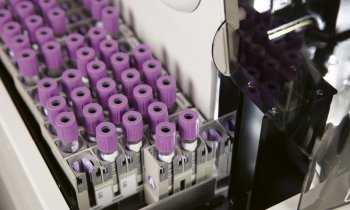
Source: American Thoracic Society
News • Chronic obstructive pulmonary disease
COPD: Biomarker for kidney disease has unexpected benefits
A commonly used biomarker of kidney disease may also indicate lung problems, particularly COPD, or chronic obstructive pulmonary disease, according to new research published online in the American Thoracic Society’s American Journal of Respiratory and Critical Care Medicine.
In “Albuminuria, Lung Function Decline, and Risk of Incident COPD: the NHLBI Pooled Cohorts Study,” Elizabeth C. Oelsner, MD, MPH, and coauthors report a link between albuminuria, the amount of the protein albumin in urine, and COPD. The researchers conducted their study by pooling information from 31,877 participants (average age: 60 years) from six cohort studies funded mainly by the National Heart, Lung, and Blood Institute.
Our study helps to explain why COPD patients often have a constellation of vascular problems, including heart and kidney disease
Elisabeth Oelsner
Albuminuria indicates damage to the single layer of cells lining blood vessels, known as the endothelium, in the kidney. Previous studies have shown that this damage is associated with microvascular (small vessel) dysfunction throughout the body, including the lungs. However, according to the authors of the current study, no large-scale, prospective study has tested whether albuminuria is associated with the development of COPD. “The pulmonary microvasculature is critical to gas exchange and known to be impaired in patients with COPD, especially those with emphysema,” said Dr. Oelsner, Herbert Irving Assistant Professor of Medicine at Columbia University. “We wanted to test whether albuminuria, a non-invasive and commonly used clinical test, could serve as a marker for increased risk of developing chronic lower respiratory diseases, such as COPD and asthma.” The researchers excluded participants who had been diagnosed with COPD or asthma upon enrollment in the studies. Participants were followed for changes in lung function over a median of 6 years and for respiratory hospitalizations and mortality over a median of 15 years.
The study found for each standard deviation increase in albuminuria, there was a:
- 15 percent increase in those who developed moderate-to-severe COPD;
- 26 percent increase in COPD hospitalizations and deaths; and
- 3 percent greater decline in FEV1 (the amount of air that can be forcibly exhaled in one second) and an 11 percent greater decline in the ratio between FEV1 and FVC (the total amount of air that can be forcibly exhaled after taking the deepest breath possible). Both FEV1 and FEV1/FVC are important measures of lung function.
The researchers found that these associations remained significant even after taking into account smoking history, diabetes, hypertension and cardiovascular disease. Interestingly, while smoking is known to cause both endothelial damage and COPD, the results were found to be similar in never-smokers. The study did not find a significant association between albuminuria and asthma.
The authors said that their findings suggest that endothelial damage in the lungs may play an important role in the development and progression of COPD. They added that the mechanisms behind that damage and behind microvascular dysfunction may present promising targets for new therapies designed to prevent or treat COPD. Dr. Oelsner noted that a clinical trial is currently being conducted to test whether angiotensin II receptor blockers (ARBs), which have been shown to prevent progression in kidney disease, may also slow progression of emphysema. “Our study helps to explain why COPD patients often have a constellation of vascular problems, including heart and kidney disease,” Dr. Oelsner said. “This makes it all the more important for clinicians to encourage avoidance of exposures like smoking and treatment of diseases like hypertension and diabetes that cause endothelial dysfunction.”
Source: American Thoracic Society
28.09.2018











